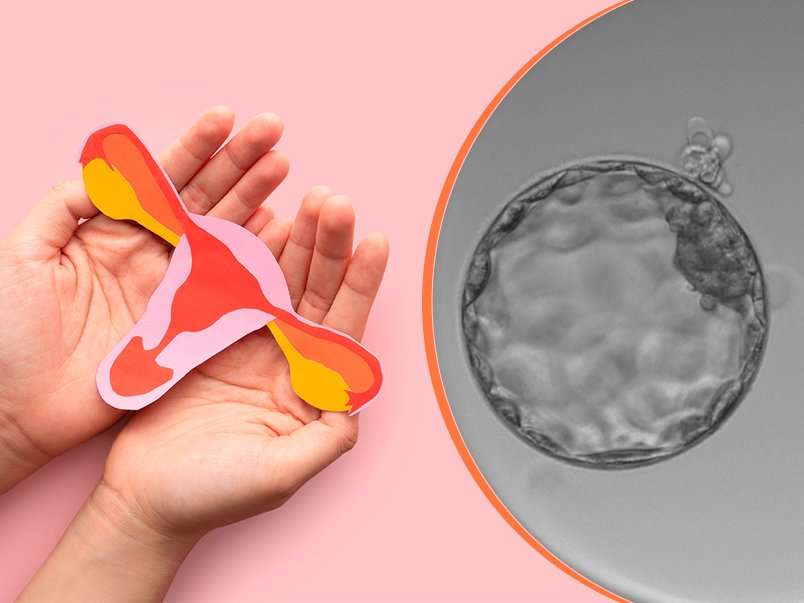blog tambre
Why do we transfer a single embryo in the blastocyst stage?

Table of contents
Today we would like to share why we at Tambre always advocate the transfer of a single embryo in a blastocyst state in all our In Vitro Fertilization treatments,
We will also explain what technologies we use to carry out these techniques which are designed to ensure that the embryos develop in optimal conditions and that the pregnancy does not pose any risk to our patients.
What is an embryo transfer and how is it done?
The Embryo transfer is the last and most important step of In Vitro Fertilisation (IVF). It is the procedure in which the embryo or embryos are placed inside the uterus.
It is a procedure that is performed in the operating room and is very simple, and requires no anaesthesia. At Tambre, a guided ultrasound is used to perform the transfer for greater precision. The doctor passes a catheter through the cervix into the uterus. The embryos or embryo are then transferred through the probe.
Why do we perform a single embryo transfer?
In Spain the law states that you can only transfer a maximum of three embryos in any one procedure. However, it is usual for the two most viable embryos to be transferred in fertility clinics. At Tambre we always advocate the transfer of a single embryo and in a blastocyst state.
It is a common assumption that the more embryos transferred, the higher the chance of pregnancy. Some studies in the past have even defended this idea, suggesting that multiple transfers helped implantation.
However, at Tambre our protocols are very strict to ensure the safety of our patients and we have the means to provide quality embryonic selection. Transferring several embryos increases the chances of multiple pregnancy and this can carry numerous risks for the mother, particularly if she is older. That is why we always opt for a single embryo transfer.
And why transfer in the blastocyst state?
An embryo in the blastocyst state is an embryo that has been developing in an incubator until day 5 or 6 of its development, beginning from the day of fertilization.
Blastocyst transfer is the most appropriate stage; in a natural gestation this is the phase in which the embryos would reach the uterus.
The blastocyst is the ideal state for the implantation of the embryo in the uterus to take place. Embryos in the blastocyst state have already developed by differentiating their cells. At this stage, the cells of the inner cell mass (ICM) that give rise to the foetus are already distinguished from the cells of the trophectoderm (TF) that give rise to the placenta.
Transfer in blastocyst on day 5 or 6 vs on day 3
Although the transfer could carried out on day 3, at Tambre we prefer to wait, since most human embryos slow down their development on this third day and, although a large proportion are morphologically normal, they are not chromosomally normal.
Therefore, we carry out the transfer on day 5 or 6 or in the blastocyst state, guaranteeing the selection of embryos with the greatest potential and the greatest implantation capacity; better endometrial-embryo communication, and choosing only embryos with the activated genome and a lower rate of miscarriage.
And most importantly, blastocyst transfer on day 5 or 6 reduces the number of embryos need to be transferred. As we have seen, the transfer is done with a single embryo or a maximum of two to minimize the risk of multiple pregnancies.
How is the blastocyst transferred at Tambre?
The blastocyst is normally carried out on day 5 after fertilisation.
Our Embryologists and Doctors, thanks to their extensive experience and with the help of our techniques, will know the right time to transfer. Once the fertilisation has been carried out, we will inform you about the evolution of your embryos and on day 3 you will be assigned an hour to carry out the transfer on day 5.
Our technologies, our insurance on transfers
Today, in the Tambre embryology laboratories we are fortunate to have unique and high-quality culture media and the latest generation Time-lapse GERI incubation system, which recreates conditions very similar to the maternal uterus.
The GERI incubator allows embryos to develop in a perfectly controlled environment, increasing blastocyst survival rates and helps select the best embryo to transfer.
Additionally, we have Preimplantation Genetic Diagnosis (PGD) that allows us to study the genetics of embryos prior to implantation. Thus we can select euploid embryos (those that do not have chromosomal abnormalities).
Transferring an embryo with PGD has an 80% – 90% more chance of implantation than without PGD. Thanks to these two techniques we can study the viability and growth of the embryos to be able to bet on the one with the greatest implantation capacity.
If only chromosomally normal embryos are selected and transferred through an IVF-PGD cycle, they have a better chance of implanting and reaching term, since the probability of conceiving a healthy child is increased.
Success rates and healthy pregnancy after transfer
With the use of these two main technologies, our team of experienced Embryologists, using blastocyst and a single embryo transfer translates to high numbers of safe pregnancies and healthy babies.
Currently our percentage of embryos transferred is 1,035 and the multiple gestation rate is 2,095%.
As we have pointed out previously, the safety of our patients during their pregnancy is our priority, therefore our multiple pregnancy rates are very low.
